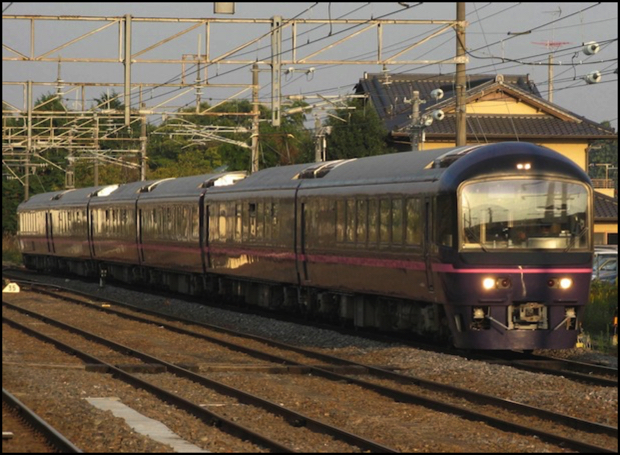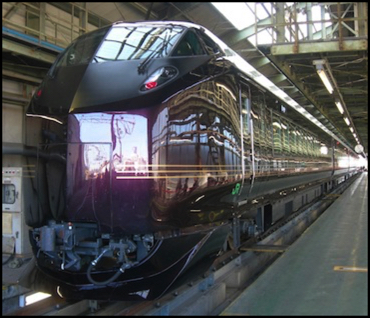Old and New: Japan’s Joyful Trains

Update: Thu 14 Oct, Kato has just announced a re-run of their 485 Nikkō/Kinugawa model for this November. Although this isn’t a Joyful Train per-se (it’s not available for charters, and several different trainsets are used for the service in addition to the 485), it’s similar and one of the few 485’s still operating out of Tōkyō (Shinjuku and Ikebukuro Stations, to be specific). It also has a variant of the 485-3000 design that I find more appealing than the older 183/481/485 design. It’s available for reservation at Hobby Search. After passing on it last year, I decided to get it this time (there goes the budget; November was already going to be a busy month due to the passenger trains I have on reservation).
I’ve also updated the Resort Trains page with some more correct info about this train, and updated the Older Limited Express and Joyful Trains pages to reference it, so I thought that worth mentioning here.
*
One of the defining characteristics of Japanese Trains, and of Japan in general, is a mania for newness. When Japan National Railways was broken up, one of the first actions of the newly-formed Japan Rail East was to begin planning a new model of commuter/suburban train with a design lifespan of just 15 years, quite short for an electric train. The reason was to lower construction and operations costs, compared with the existing trains that were due for replacement and very labor-intensive to operate and maintain. But it also had a PR dimension, in that JRE needed to shake off the public perception that JNR had as being out-of-touch with its passengers, and a new fleet of trains without the two or three decades of wear their then-current trains had was a good way to do that, by catering to the perception that “new” equated to “improved”. That effort was successful, and while most of that first generation of “15 year” trains (the 209 Series) are still in service, they’re gradually being replaced by the new generation of E231/E233/E531 commuter and suburban trains which form the bulk of my collection (and which, to be fair, do represent a substantial improvement over the 1960’s technology JNR had been using, in both comfort and economy).
But at the same time, older trains remained in service, and some still remain, now approaching 40 years of age (if not more). Chief among these are the 485 Series, which operate in a variety of regional roles. My Viva Aizu 485-1000, which headed up my earlier post on Japanese Trains, is the only 485 in my collection at present (mostly because I don’t find the design all that appealing myself).
But the other interesting aspect of the 485 is that some of the newest trains in JR East’s stable are also some of the oldest. Starting in the 1990’s, surplus 485 cars were radically overhauled to create “Joyful Trains”; trains used for corporate and other charters, typically to bring groups of employees to resort areas on company-sponsored trips. Although each Joyful Train is unique, a number of similar design have been made. These trains were very popular during the inflationary period known as the “Bubble Economy”, although use has been declining since the collapse of the bubble. The picture above (from wikipedia) is one of these converted 485 Series trains, the Hana.
These trains kept the basic mechanicals and probably some of the body, but the interiors were all new, and very luxurious, including the replacement of the cab ends with panoramic windows. In some the seating was replaced with woven tatami-mat flooring and on-the-floor seating, similar to that found in some traditional resorts. And often one car would be equipped with a single long table (also intended for diners sitting on the floor) as a banquet car. Other trains had a Western flavor, with carpeted floors and upright seating (as least some of it equipped as recliners).
The reason I’m mentioning this is that Micro Ace has announced the re-issue of the Hana and two other similar Joyful Trains for March of 2011. As Micro Ace almost never reissues trains (although they’ve been doing more of that lately), this is cause for celebration. I’ve already reserved my Hana, and its two siblings (through Hobby Search), and now I just have to wait six months for them to show up.
Of course, not all Joyful Trains are reconditioned 485 Series. Another interesting one (unfortunately with no model available at present) is the Nagomi, also known as the Imperial Train. The Nagomi is a five-car Joyful Train, more formally known as the E655, based on Hitachi’s double-wall aluminum body design and modular interior fittings (which they call A-train technology), some of the most cutting-edge Japanese train technology.
The Nagomi is also known as the Imperial Train because there is a sixth car, only used by the Emperor and his guests, which is normally kept separate from the train. In the five-car arrangement, the Nagomi is available for charters, in the six-car arrangement it is not (the sixth car bears the Imperial Chrysanthemum symbol on its side, and the train carries it on the front, when the Emperor is aboard). The current Emperor, however, appears to prefer to travel by other modes of transportation (including an ordinary Shinkansen, albeit in a reserved car) and the Imperial Train has only been used for that purpose twice since its construction in 2007, the second time just this past month.
E655 Nagomi at Oku Depot (wikipedia)
Other website changes:
- I rewrote my Limited Express page to add considerable text, breaking it up into three pages in the process: one page with the more recent Limited Express trains, one describing the remaining older 18x/48x Series trains, and one for Joyful Trains.
- I’ve added a page, still something of a work in progress, about the various forms of Electric Propulsion used on Japanese trains (this is focused on conventional trains, and doesn’t touch on monorails or maglev trains).
- I’ve updated the Reservations page to note the new reservations, as well as a couple of arrivals.




